Discourse surrounding the term tranny has become more than a little heated. In fact, a RuPaul Drag Race runner-up enacted the mock execution of a trans woman named Parker Molloy for the apparent crime of asking that folks not be so casual with the language people use while killing trans people. Andrea James thought the mock execution was “hilarious” and a HuffPo Gay editor promoted the video.
There’s a number of posts out there critiquing the mock execution of Parker Molloy. This article will not substantively focus on these current issues. Instead, it will focus on the evidence-based history of the term because I’ve noticed a common historical narrative used when defending the use of the term. According to the narrative, tranny as a trans term goes way back. In fact, they assert, the term didn’t have a negative connotation when used way back when.
Writing for the Advocate, Calpernia Addams wrote:
But tranny has evolved, from scattered in-community usage by drag and trans entertainers to accreting negative connotations from its frequent use as a dismissive semi-insult — it’s gone from “Those trannies kicked ass last night when they got raided at Stonewall” to “Ugh, look at that hot tranny mess!”
Addams recounts the latter meaning in her 2008 video, Bad Questions to Ask a Transsexual: Old Version. The video, which has almost half a million views, juxtaposes the term tranny with fag. This purposeful invocation of the slur fag is contextually important as it represents the only place in the video wherein fag is used.
Bad Question #10: ‘Girl, are you a tranny?’
[derisive laugh]
I usually get this one in gay bars and it’s usually coming from fags who already know that I’m transsexual. They’re just trying to let me know that I’m not getting away with anything. It’s kind of like saying, ‘Wow, you look really slim. Are you wearing a girdle?”
Backhanded compliment much? I’ll backhand ya!
Addams makes it clear that the current contextual meaning of tranny is not something she appreciates being applied to her experience. While it seems that Addams’ estimation of tranny is empirically shared among many trans women (as evidenced by strong social media backlash), the historical narrative Addams offers is not so easily supported by evidence.
Recently, the TransAdvocate featured a peer-reviewed paper looking at the historical rhetoric surrounding the term transgender. While doing research for this paper, I also looked into the historical context of tranny. The reality is that I did not find uses of the term earlier than 1983. Some have asserted that the term was in use before the term appeared in print and I would agree that this is likely the case. However, I can find no evidence to support the belief that the term was in wide use years or even decades before it appeared in print. This suggests that the term only gained cultural currency in the early 1980s.
What follows is a review of the term as it has been applied within media. The purpose of this article isn’t to stoke the ire of any particular lexical faction. Instead, I invite you to review the evidence and thoughtfully consider the two debatable questions at the end of this article.
The Oxford Dictionary of English Slang (p. 336) has the following entry:
Trannie: Noun. A transvestite. 1983 -. GAY TIMES “By 11 pm they seem drunkenly immune to the influx of trannies, trendies, and other creatures of the night” (1990). [From abbreviation of transvestite + -ie.]
Word Usage: Historical Context
1985
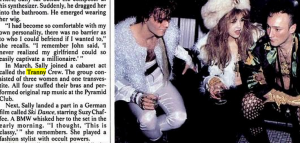
“In March, Sally joined a cabaret act called the Tranny Crew. The group consisted of three women and one transvestite. All four stuffed their bras and performed original rap music at the Pyramid Club.”
1986

“First man on the cover of Cosmopolitan, first man to say he preferred a cup of tea to sex – Boy George came to see himself a the tranny who tamed the world, or at least the global village.”
1991

“Queer means to fuck with gender. There are straight queers, bi-queers, tranny queers, lez queers, fag queers, SM queers, fisting queers in every single street in this apathetic country of ours.”
1993

“Cross-dressers often desire, not the security of a perfect imitation, but rather the delicious impersonation that belies complete disguise: the hairy leg in the lace suspender, the bald pate in the bonnet. In ‘tranny‘ (transvestite) publications such as The World of Transvestite, a man’s hairsuit calf protrudes beneath the silken skirt, the shadow of an erection is pressed against the lacy lingerie.”
1994
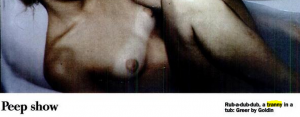
“Rub-a-dub-dub, a tranny in a tub”

“Karen nodded. “He worked the tranny strip on Davie off Burrard. How’s your hand?” She eyed the splints on his fingers. “I’m ambidextrous,” Nick said, and threw her a smile. “Gimme crack and I’ll rim you,” Karen whispered.
1998
The domain tranny.com is created
2000
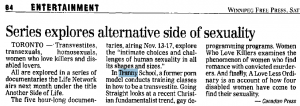
“In Tranny School, a former porn model conducts training classes in how to be a transvestite.”
2002
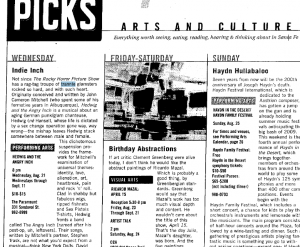
“Not since The Rocky Horror Picture Show has a rag-tag troupe of trannie glamsters rocked so hard, and with such heart. Originally conceived and written by John Cameron Mitchell (who spent some of his formative years in Albuquerque), Hedwig and the Angry Inch is a musical about an aging German punk/glam chanteuse, Hedwig (ne Hansel), whose life is dictated by a sex change operation gone way, way wrong—the mishap leaves Hedwig stuck somewhere between male and female.”
2003


“Otherwise, transgender characters “are primarily brought in .during sweeps,” laments Adams, “where they’re either the ‘tragic tranny‘ — homeless, murder victim, killer — or, when there’s a sort of liberal paternalism: Oh, these poor sick people, we really need to help them.'” He notes that a recent episode of CBS’ operated CSI centered on “an elusive criminal mastermind, a serial killer, where it’s revealed that he had a sex change operation from female to male, with creepy flashbacks and horror music behind it.”
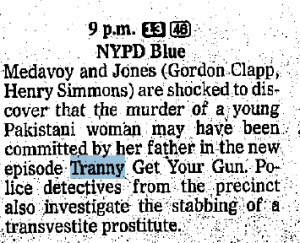
Clip from NYPD Blue’s “Tranny Get Your Gun”
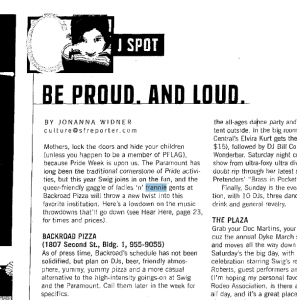
“Mothers, lock the doors and hide your children (unless you happen to be a member of PFLAG), because Pride Week is upon us. The Paramount has long been the traditional cornerstone of Pride activities, but this year Swig joins in on the fun, and the queer-friendly gaggle of ladies ‘n’ trannie gents at Backroad Pizza will throw a new twist into this favorite institution.”
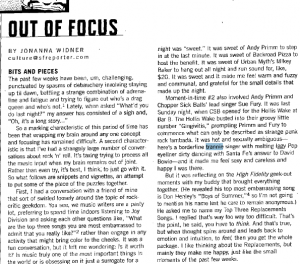
“Moment-in-time #2 also involved Andy Primm and Chopper Sick Balls’ lead singer Sue Fury. It was last Sunday night, when CSB opened for the Hollis Wake at Bar B. The Hollis Wake busted into their groovy little number “Gingivitis,” prompting Primm and Fury to commence what can only be described as strange punk rock lambada. It was hot and sexually ambiguous— here’s a borderline trannie singer with melting Iggy Pop eyeliner dirty dancing with Santa Fe’s answer to David Bowie—and it made me feel sexy and careless and happy I was there.
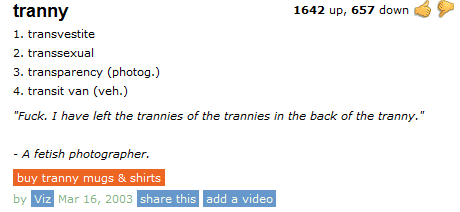
2004
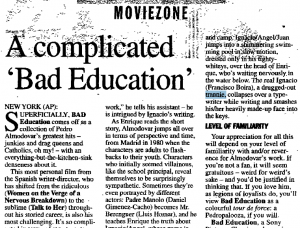
“The real Ignacio (Francisco Boira), a drugged-out trannie, collapses over a typewriter while writing and smashes his/her heavily made-up face into the keys.”
2005

On Saturday, Nov. 12, Wise Fool New Mexico hosts Lynnee Breedlove and her One Freak Show. Breedlove has been entertaining audiences for nearly a decade with her queer punk band Tribe 8, and her one-person One Freak Show is pure icing on the tranny cake. Billed as a performance of “queer homohop punkrock sugarcoated feminist tranny theory.- stand-up comedy on transgender bodies, family, and community,” Breedloves show is a multifaceted exploration of gender issues through the eyes of one of queer cultures most outspoken and humorous devotees. Through music, spoken word, and some creative use of stuffed animals, the politics of sexuality get a much needed dose of not-so-serious self-examination.
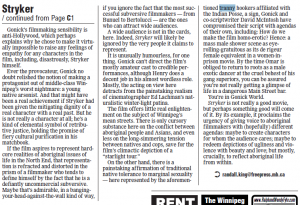
“On the other hand, there is a painstaking affirmation of traditional native tolerance to marginal sexuality — here represented by the aforementioned tranny hookers affiliated with the Indian Posse, a sign, Gonick and co-scriptwriter David McIntosh have compromised their script with agendas of their own, including: How do we make the film homo-erotic?”
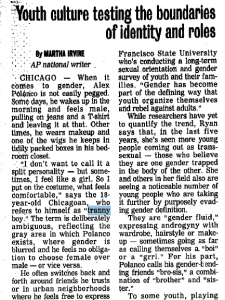
“I don’t want to call it a split personality — but sometimes, I feel like a girl. So I put on the costume, what feels comfortable,” says the 18-year-old Chicagoan, who refers to himself as “tranny boy.” The term is deliberately ambiguous, reflecting the gray area in which Polanco exists, where gender is blurred and he feels no obligation to choose female over male — or vice versa.”
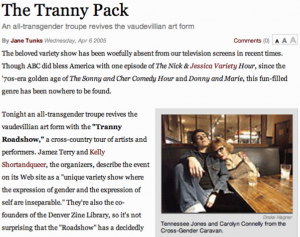
“The Tranny Pack – Tonight an all-transgender troupe revives the vaudevillian are for with the”Tranny Roadshow.” a cross-country tour of artists and performers.”
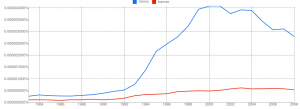
The above graph reviews the frequency in which the terms “tranny” and “trannie” were used in books published between 1983 and 2008. It’s worth noting that until the 1980s, the term “tranny” referred to any of the following words: transistor, radio, television, photograph or transmission. However, note the rise in the words use between the 1994 – 2001. Since this spike corresponds with a spike in other trans terms, it’s reasonable to conclude that it was in first part of the 1990s that “tranny” entered into common usage by society at large.
Current Contexts
Now that I’ve reviewed the way in which this term was used in a historical context, let’s look at the way our culture currently uses this term:
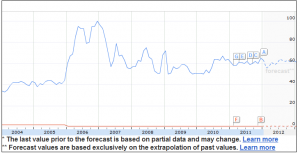
The above graph is a review of the frequency people use google to search for “tranny” and “trannie” between the years 2003 and 2011. During the last year (2011), a number of incidents account for spikes in the search trends:

Now lets look at exactly what people look for when they’re google’n “tranny” and “trannie”:
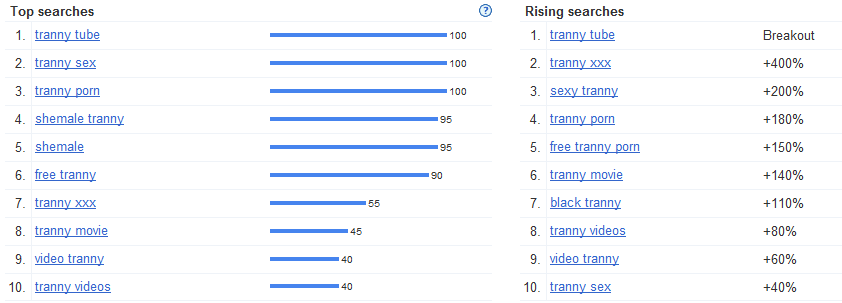
How does interest in “tranny” and “trannie” stack up against other trans terms such as “transsexual” and “transgender”?

When the data are narrowed to specific categories, interesting trends arise:
- Arts & Entertainment (TV & Video, Online Media):

- Online Communities (Dating & Personals, Forum & Chat Providers):

- People and Society (Ethnic & Identity Groups, Social Issues & Advocacy):

- News (Gossip & Tabloid News, Celebrities & Entertainment News, Newspapers):

(Note: The bars in the graph represent averages for each line on the above chart graph)
Wrap up
From the evidence available to me, I feel that I can draw some conclusions:
- This term seems to have originated from the gay male community.
- This term seems, in its original context, to relate to performers (closely associated with the party culture) of one type or another.
- The term became more closely aligned with the drag community (both FTM and MTF) in the 1980s to mid-1990s.
- The term became more closely aligned with the sex industry in the mid-1990s and this seems to be an upward trend.
- The term dominates google searches by orders of magnitude in most areas (especially in the media) with the exception of specific social causes.
- There seems to be a disconnect between the gay and drag community’s uses the term “tranny” and the way the term “tranny” is most commonly used outside of these communities by the society at large.
Some debatable questions:
- What impact does an obviously very popular context of framing the trans experience (tranny) have on social justice movements?
- When the majority clearly associates “tranny” with the sex industry while the gay and drag community associates the term with performance and partying, will this affect the ability of the GLBT community to communicate well?

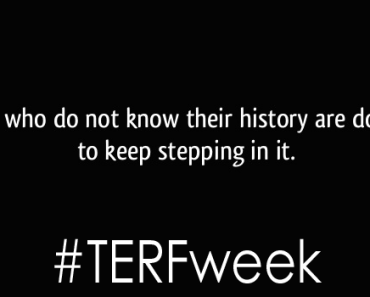
Wait, where are the Australian sources? Many have asserted over the years that the term originated in Australia. So surely there needs to be an examination and comparison of Australian sources and usage?
Toxic thinking.
https://www.facebook.com/CRMT.AU/photos/a.329591917149986.69815.154657401310106/530895173686325/?type=1&theater
Today, the NBA banned a team’s (Clipper’s) owner for life, “in the best interest of the sport”—merely for uttering a private remark confirming his long-held deep and personal race-based bigotry. The remark was extremely hurtful and hateful, but never did it come even close to being physically violent, either direct or implied, and yet the costs for such a private utterance will run into the millions of $.
Concurrently, we have gay-advocated trans violence that at minimum caricatured/mocked trans identities and at maximum “green-lighted” the option of armed violence on we, the trans community. Employing video metaphor, the “hilarious” video fooled no one in that it was a message marinated in trans hatred, sponsored by the scorn, and publicly delivered in the spirit of vengeful retribution. Using a simulated firearm, a trans person was “publicly executed” for the world to see. All because we the trans community succeeding in the removal of trans slurs from a gay-sponsored “show” broadcast to the public. No one is a higher authority in policing LGBT hate speech more than Gay, Inc.
The video was deemed so egregiously hurtful that it was quickly/swiftly retracted. An apology “tucked away” in Gay Voices edited by now-proven trans-phobic persons took its place. It was not voluntarily removed, but only after receiving pressure from GLAAD and the trans community. One shudders to think of the mindset behind those who initially considered the video as acceptable, given that it targeted an already violent-prone community. I suggest a tattoo: TDOR.
Far worse than mere racist remarks, a public video simulating trans violence sponsored by Gay, Inc. begs for far, far more accountability than mere “business as usual.” If racist remarks are not “in the best interest” how much worse was this video in that it wasn’t “in the best interest” of LGBT folk, specifically T folk? One person will never speak for all, however I know I speak for many by stating that this video wasn’t a “mere” exercise of bigotry. It was/is so horrendous, that I and many others will never rest until the bill due is paid: holding Gay, Inc accountable for putting retribution as the “best interest” over the best interest of we, the trans community. To think all of this is because we dared to challenge words that feed a mindset that we have fought for over 60 years now—a mindset that states “the only real females are those born female. Everyone else is a “she-**le”.
A focus on the nomenclature of violence, which includes hate speech—derisive words that serve no constructive purpose and historically coincide with violent acts toward others is never wasted energy. Calling out those who freely exercise such speech, no matter how rationalized, is righteous indignation, which if not exercised only leads to more indignation. Allow me to explain:
None of us are trying to change character—such is accomplished only by within the person with such a flaw. We would, however, be beyond foolish if we pretended not to know that outside LGBT circles, some words are so offensive that like flatulence, they should remain only “indoors”. Such a “safe” context has historically been within LGB circles. Clearly, this context was the reason behind why the Drag Race Show felt it was safe to exercise the use of such words—to the public. I find it beyond belief that the Drag Race Show didn’t already know that such “safe” words are anything but in a non-LGBT context. They are not. Such words also serve to de-legitimize an otherwise medically sanctioned and legally accepted sex/gender change—something absolutely critical for those of us who are not drag performers but live 24/7 as female. This very notion is what empowers others to mistreat us as female impostors, despite proving our female sex per our ID. Incidents continue to occur relating to restroom, gyms, or private establishment access where IDs are required to be checked.
This very obfuscation is behind trans girls being arrested, harassed, evicted and even attacked merely for trying to use a restroom. It is behind state/local governments trying to pass laws that render ID sex markers as invalid—overruling MDs who, under law are considered as sex (M/F) experts. This is the end result of promoting some females as “other”, such as what the Drag Race show was exactly doing, despite whatever entertainment value it had. Ultimately, although not without protest, the Drag Race Show discontinued this segment and all appeared to be over and we know how it became what we have now.
Again, this all began only after RuPaul apparently refused to budge, became upset at our protest, and callously refused to acknowledge our perspective. Like others commenting here, we are making a mountain out of a molehill. Write my name in the “Vehemently Disagree” column….in ink, precisely for the real-world horrific impact to trans females on the ground. Few words express hostility as strongly as using the “fuck” word in defense. This very posture set the tone for the rancor that followed, including my own fervent protest. There is no humor to a video message that says “Fuck off or die”, even if cloaked as comedy.
Culpability doesn’t rest with the defender—but with the offender. This entire debate began from the gay community’s promotion of trans-demonizing words–a community who historically has discounted a bonafide 24/7 sex change/transition as nothing more than “gay boys dressed up as girls”. Trans children (that we were) of today have for at least 10 years now proven that gender identity is as simple as being male or female—not performing as one. Of course they wouldn’t know this because it’s “Gay Voices” and “Gay Voices” only that is their concern.
*Others commenting here state that we are making a mountain out of a molehill.
http://k80theshade.wordpress.com/2014/04/30/a-reply-to-dee-in-wp-article-comment/
I couldn’t agree more with Marilu Rose Fanning. The use of a word is harmful only in a harmful context. I have always used this word to refer to myself and others. Also, others have used this term to describe me both with and without hostile intent. In all cases, the intent behind the usage is what is important, not who is using it to describe whom.
And yes, all the focus on usage, especially by the media, is harmful in the extreme to our cause.(The present discourse excepted, obviously)
As for the impact of any focus on the use of words absent some context, the consequences seem fairly obvious to me: The movement for equality has only so much energy to expend to the cause, so it ought to be directed carefully in a more concentrated manner, not wasted on trivialities. Keep in mind that any energy expended ought to have an appreciable return, and this methodology appears inconsistent with any address of the usage of petty words. It’s a bit like soldiers on one side of a battlefield ceasing hostilities long enough to stage a hunger strike about the smell of the gunpowder. It makes no sense.
As for how it affects our ability to communicate, I just can’t see how a person trying to communicate with me about anything at all would not find that task more difficult if they were concerned about whether I might take offense at a word they might use while meaning no harm.
If I’m the one doing the communicating, I don’t want people to hang on my use of a single word of my discourse only to miss the overall theme because they were too caught-up about my usage.
And don’t even get me started on the bathroom thing.
No one ever called me tranny in a bad way, but i used to be heavily bullied and called queer nearly every day for years in school. Especially in the locker room… Where i was phyically ASSAULTED in school while the boys played a game called “Smear the Queer”. On several occasions I had gym shirts and towels thrown over my head while fists came from all sides to beat me to the ground. All the while I heard the word queer. Yet the word queer doesn’t cause me to relive the trauma unless I think of the trauma specifically. I don’t need people in the LGBTQ community to cease using the word which was directed at me with hate, and certainly there are too many people who use it positively to care if I was hurt by it. Everyone has their own individual experiences which validate and invalidate different sets of words. The word queer used to cause me to clam up and cry, now it doesn’t. Tranny has never once affected me. Of course, I also don’t internalize my problems, I rant at my therapist who is educated enough to set me on the right path and think positively.
Cristian, First let me say, that I am a big fan of yours. I was very proud of the way you exposed the PJI as the evil frauds that they are and protected that high school girl. I think that you do a wonderful Job. I’m an older Trans woman, (in my 60’s) and have seen so much progress within my lifetime. Progress that I would never have dreamed that we would achieve just 20 yrs. ago. I think that full equality is just around the figurative corner. I’m hoping it comes within my lifetime. It seems like we have reached the point now that it is inevitable. I think that this whole word controversy is just so much wasted energy over so little and is distracting us from more important things. You cannot eliminate disrespect by demonizing the words that some people use to convey disrespect. That’s just political correctness run amuck and only makes us look petty and foolish. Nearly every term invented during my lifetime that has been used to describe trans people has been used disrespectfully. Changing terminology doesn’t eliminate the disrespect that’s behind the use of those words by some people. I also watched the video in question and I found it to be a sarcastic, witty, and funny response to the criticism and trying to refocus its point to the extreme notion that it was “disturbing” and all about killing an overly sensitive Trans girl by hair dryer is just ridiculous. That kind of tactic just means that your argument is too weak to be effective. Again making us ALL look petty and foolish. I would think that this whole series of petty bickering can only be counter productive and not only reduce the level of respect that we receive as a community, but also reduce the level of respect that you need as a serious journalist when representing us. Anyway, that’s my take on it. Keep up the good work!
A hair dryer that was held like a gun, made gun sounds, and left a bleeding bullet-wound in the character’s head. Not really that much of a clever disguise. I have zero doubt that the reason it was a hair dryer was because the video’s creator didn’t happen to have a replica gun handy.
Even in the military, as AF combat-trained (since Vietnam) MPs tasked with the ability to defend USAF bases, simulations were conducted as dress rehearsals for actual combat defense. Even though we were AF “troops”, many don’t know that the reason AF bases are so well-defended is because AF MPS attend two schools: MP school and a separate combat field-training/infantry school (very rigorous) using US Army techniques and manuals (80’s).
My point? Simulating murder is still a simulation…of the real and violent deed. What was the point of the video? Duh….ask any 1st grader and they will get the answer correctly also.